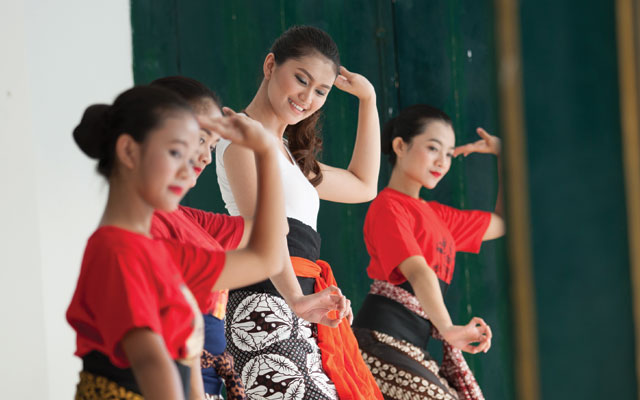An expanding inventory of meeting facilities has allowed Yogyakarta to support a growing number of association gatherings

Yogyakarta may be better known as a leisure destination and lacks the extensive convention and meeting infrastructure found in its sister cities Jakarta and Bali, but the city rich in culture and heritage is no greenhorn to hosting major business and association gatherings.

At the start of the new millennium, Yogyakarta became the first secondary destination in Indonesia to win the hosting rights to a national healthcare association meeting despite not having a convention hall. This was made possible by the efforts of major hotels in the city.
Since then, Yogyakarta’s infrastructure has seen improvements with the emergence of new hotels and better meeting facilities.
Correspondingly, tourism data is showing growth. The Yogyakarta tourism office reported 11,377 business and association events in 2015. These were attended by 841,711 participants. The following year there were 13,587 events with 1.6 million participants.
The numbers continued to climb and in 2017, Yogyakarta hosted 15,262 events with 1.7 million participants. Among these were TEFLIN (the Association for The Teaching of English as a Foreign Language in Indonesia) International Conference, Asian Association of Open Universities Annual Conference, Kumon International Conference, Asian Conference on Clinical Pharmacy, and Asian Aroma Ingredients Congress.
Most recently in April, the city hosted the Center for International Forestry Research’s 3rd Asia Pacific Rainforest Summit, an event that drew more than 1,200 delegates.
Aris Riyanto, head of Yogyakarta Tourism Office said his city’s ascent in the association meetings space was a result of “its rich history combined with its culture and adventure”, which he believed were “strong draws” for attendees.
Arif Hidayat, president director of Exponent Cipta Media, agrees, pointing out that Yogyakarta’s “wealth of heritage and culture” has bestowed the city with many unique venues and activities.
He referenced the ruins of Ratu Boko Palace and Prambanan temple grounds as examples. The former can take up to 300 people for an outdoor reception, while the latter is great for a 1,000-pax dinner with Ramayana ballet performed against the temple backdrop.
Furthermore, Yogyakarta’s heritage and culture will also encourage associations in culture, arts, medical, education, environment, history, anthropology and archaeology sectors to meet in the city.
For Fadli Fahmi Ali, director of destination specialists Werkudara Nirwana Sakti, Yogyakarta’s creative community is a strength.
“Here, we can easily find dancers, actors, choreographers, musicians, filmmakers and puppeteers who can break the boundaries of ideas and styles to make events more special,” he explained.
Equally critical to Yogyakarta’s sustainable success in the meetings business is the availability of events hardware. Currently the city offers the Jogja Expo Center which can accommodate up to 9,670 people theatre-style, and The Alana Yogyakarta Hotel & Convention Center for up to 2,700 people theatre-style. Royal Ambarrukmo hotel, with its 1,500m2 ballroom and 20 break-out rooms, is perfect for conferences with multiple concurrent sessions.
For meeting planners in search of venues with a little more cultural flavour, the grand Hotel Tentrem makes a good option with its traditional architecture. The hotel boasts a 1,872m2 hall and nine meeting rooms.
Yogyakarta’s inventory of hotels with quality meeting facilities continues to expand, most recently with Yogyakarta Marriott Hotel. Opened in October last year, the hotel features a 1,867m2 ballroom and eight breakout rooms.
Denny Ristyanto, director of sales and marketing with the young hotel, told TTGassociations that there has never been a quiet day at the hotel since its opening.
“We continued to get event bookings up till the end of the year (when business meetings typically slow down),” he shared, adding that the hotel’s varied facilities appeal to business and association meeting planners.
While only 10 per cent of event bookings were from international associations, Denny is confident of growing that share to more than 30 per cent in 2018.
Arif opined that with Yogyakarta’s current hardware, the city is capable of welcoming medium-sized meetings of 700 to 1,500 participants.
What industry players hope to see more are improved accessibility and stronger destination promotions.
Yogyakarta’s only direct flights are provided by AirAsia from Malaysia and Singapore. Delegates from elsewhere must connect from other airports, creating logistical challenges for planners of large-scale international meetings.
Ian Mcdonald Cameron, general manager of Royal Ambarrukmo Yogyakarta, hopes the government’s plan to develop a new airport in Kulon Progo Regency by 2020 would materialise.
The current Adisutjipto International Airport – the only airport in Yogyakarta – has a short runway that does not allow large-bodied aircraft to land.










